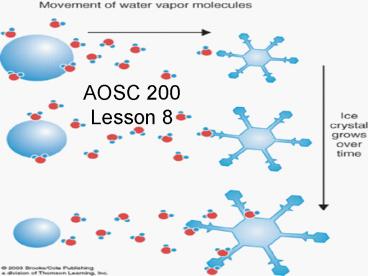AOSC 200 Lesson 8 PowerPoint PPT Presentation
1 / 24
Title: AOSC 200 Lesson 8
1
AOSC 200 Lesson 8
2
Precipitation Growth in Warm Clouds
- Cloud droplets are typically 10 microns in size.
small raindrops are typically 1000 microns
(almost one million droplets) - How does one go from one to the other?
- Simplest explanation is that the droplet grows by
condensation of water vapor on its surface. But
this would take several days. - One way for raindrops to form is by a processes
known as collision-coalescence. - This process requires lots of droplets - high
absolute humidity - seen only in the tropics.
3
Collision-Coalescence
- Warm cloud because process because it only occurs
in the tropics. - As the cloud droplet is formed it is pulled down
by gravity but then is moved upward by the rising
air within the cloud. Hence within a cloud one
has droplets moving in all directions and they
can collide and form larger droplets by
coalescing. - Once a drop grows to a size when the force of
gravity exceeds the uplift from the rising air,
the drop moves downward through the cloud picking
up other droplets as it falls.
4
Collision Coalescence
5
Collision-coalescence process
Fig. 4-31, p. 114
6
Precipitation Growth in Cold Clouds
- Outside of the tropics there are just not enough
cloud droplets to form rain drops by the
collision-coalescence process. - A Swedish atmospheric physicist, Dr. Bergeron,
would vacation in the fall in the mountains. He
often took an early morning walk along a path
that led through a pine forest and encountered
uplift fogs. - He noted that on the days when the temperature
was above 0 C, the fog went all the way to the
ground, whereas if the temperature fell below -10
C, the fog lay above the tops of the trees.
7
Bergeron walk
8
Why?
- He further noted when the temperature fell below
-10 C, that the pine needles were covered with
ice. - The reason is that the vapor pressure of water
above ice is less than the vapor above water.
9
Attraction of water vapor to ice versus water
Fig. 4-33, p. 116
10
Saturation vapor pressure over ice and over water
Fig. 4-35, p. 117
11
Fig. 4-34, p. 116
12
Accretion and Aggregation
- It should be noted that the ice crystal growth
gives a snow flake which eventually will also
begin to fall and then rise in the updraft. - These ice crystals then begin to aggregate into
larger snowflakes. - The ice crystal can also collide with a
supercooled water droplet which instantly freezes
- accretion. - As the ice crystals descend at some point the
temperature can rise above 0 C, and the crystal
melts to form a raindrop.
13
Process of aggregation
Fig. 4-32, p. 115
14
Aggregation
15
Fig. 4.27
16
These picture shows fall-streaks. They consist of
ice particles that have fallen out of a cloud and
evaporate before they reach the ground.
Fig. 4.33
17
Steps in the formation of the precipitation types
Fig. 4.38
18
Warm Front
Fig. 9.13
19
Fig. 4-37, p. 118
20
FORMS OF PRECIPITATION
- RAIN - DROPLETS OF WATER GREATER THAN 0.5 MM IN
DIAMETER. WHEN DROPLETS SMALLER THAN 0.5 MM
CALLED DRIZZLE. - MUCH RAIN STARTS OUT ALOFT AS ICE CRYSTALS
- SNOW - ICE CRYSTALS. IF AIR IS COLD (LOW
HUMIDITY), WE GET LIGHT AND FLUFFY SNOW (POWDER).
IF AIR IS WARM THAN ABOUT -5 CELSIUS, THEN WE GET
WET SNOW (GOOD FOR SNOWBALLS). - SLEET - SMALL PARTICLES OF ICE. RAINDROPS
ENCOUNTER FREEZING AIR ON DESCENT. IF FREEZING
NOT COMPLETE - FREEZING RAIN. - HAIL - LAYERS OF ICE FORM AS THE HAILSTORM
TRAVELS YUP NAND DOWN IN A STRONG CONVECTIVE
CLOUD - RIME - FORMED BY FREEZING OF SUPERCOOLED FOG ON
OBJECTS.
21
The effects of airflow over a mountain
Fig. 4-42, p. 122
22
Clouds and Precipitation near Mountains
- As air ascends mountain it cools adiabatically,
clouds form, and precipitation occurs. - Above this altitude the relative humidity stays
at 100 - At the peak of the mountain the absolute humidity
is determined by the saturation vapor pressure at
-12C. - As the air descends its absolute humidity remains
the same as at the peak
23
Clouds and Precipitation near Mountains
- As the air descends it is compressed, so it warms
- Hence the saturation vapor pressure will
increase, and the relative humidity will decrease - The net effect of the air ascending and
descending the mountain is that the air becomes
drier and warmer. - On the island of Hawaii, the west side of the
coast (westerly winds) has rain forests, the
eastern side has deserts.
24
Table 4-4, p. 123

